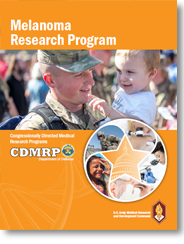Melanoma
Vision – Prevent melanoma initiation and progression
According to the National Cancer Institute, there were 91,270 new cases of melanoma diagnosed in the U.S. during 2018. Melanoma cases have been increasing steadily over the last 40 years. It is the fifth most common type of cancer in the United States, representing 5.3% of all new cancer diagnoses every year. Melanoma is of particular interest to the U.S. military because active duty Service members spend prolonged periods outside, especially during deployment. Recent studies suggests that exposure to high levels of solar radiation in young adulthood is associated with a higher risk of melanoma mortality. Melanoma diagnoses are increasing among active duty Service with the greatest incidence rates in the Air Force, Navy, and the Marines. Given the extreme and harsh conditions Service members face in theater and the rise of this aggressive and frequently deadly form of cancer, the U.S. Congress established the Melanoma Research Program (MRP) in the Department of Defense appropriation with an appropriation of $10 million. With this new program, MRP will invest in research focusing on the prevention, detection, diagnosis, and treatment of melanoma for the benefit of Service members, Veterans, their families, and the American public. In the inaugural year, the MRP sets forth a Challenge for the research and clinical community to change the approach to melanoma prevention, treatment, and long term care.
Resources for Investigators:
- FY24 MRP Funding Overview
- FY24 MRP Funding Opportunity FAQ
- FY19 Melanoma Research Program Stakeholders Meeting Summary
- FY21 Melanoma Research Program Landscape
References:
Lea, C.S., et al. (2014) Melanoma Incidence Rates in Active Duty Military Personnel Compared With a Population-Based Registry in the United States, 2000-2007. Military Medicine 179, 3:247-253.
Riemenshneider, M.D., et al. (2018) Skin Cancer In The Military: A Systematic Review Of Melanoma And Nonmelanoma Skin Cancer Incidence, Prevention, And Screening Among Active Duty And Veteran personnel. JAAD 78, 6:1185-1192.
![]()
Congressional Appropriations
- $140 million
FY19-23 - $40 million
FY24

Funding
Summary
- 175 Awards in
FY19-23 - Recent Applications Recommended for Funding

Programmatic
Panels

Peer Review Participants
Dr. John Kirkwood
Former Programmatic Panel member, University of Pittsburgh Medical Center
Addressing the Modern Epidemic Among Military Service Members
Samantha Guild
President, Aim at Melanoma
Programmatic Panel Member
Advancing research to end melanoma as we know it
Ze'ev Ronai, Ph.D
CDMRP Melanoma Research Program, Programmatic Chair Emeritus, Sanford Burnham Prebys Medical Discovery Institute
Early Detection and Prevention is the Name of the Game
Last updated Monday, March 17, 2025

















.jpeg)
